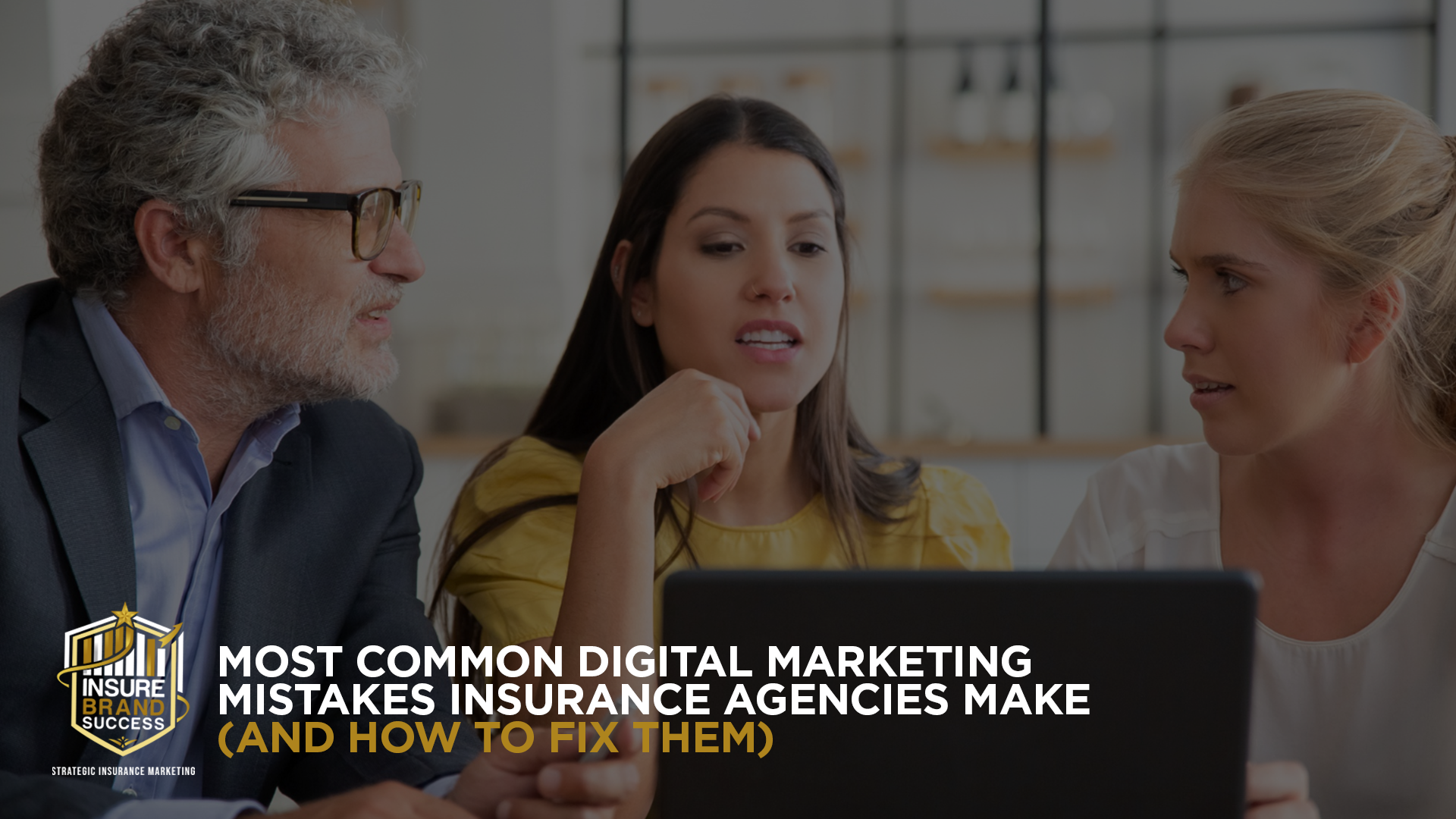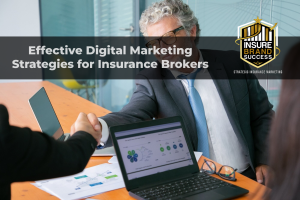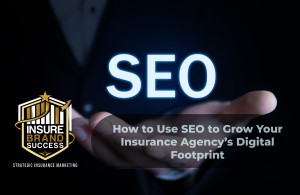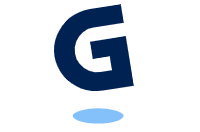Most Common Digital Marketing Mistakes Insurance Agencies Make (And How to Fix Them)
Running an insurance agency in today’s fast-paced digital world isn’t what it used to be. The competition is fierce, the market is crowded, and your potential clients are more empowered than ever before. With just a few taps on their phone, they can compare policies, read reviews, and choose from a sea of options—all without ever stepping into your office. It’s a buyer’s market, and if your agency isn’t standing out online, you’re falling behind.
But here’s the thing: standing out doesn’t necessarily mean spending more money on advertising or trying every shiny new marketing trend. It’s often about avoiding the mistakes that silently chip away at your growth. The errors you don’t even realize you’re making could be the very reason your competitors are stealing your leads and your efforts aren’t translating into results.
Think about it: have you ever wondered why your social media posts aren’t generating engagement? Why your website isn’t bringing in new leads despite all the traffic it gets? Or why potential clients request quotes but never follow through? The truth is, most insurance agencies fall into the same traps—and the good news is that these mistakes are fixable.
What if instead of working harder, you could work smarter? What if you could identify the gaps in your strategy, make a few tweaks, and see measurable improvements in leads, client retention, and revenue? That’s what this guide is about: helping you understand the common digital marketing mistakes insurance agencies make—and how to fix them.
The beauty of uncovering these mistakes is the “aha moment” it brings. It’s not just about recognizing what’s wrong; it’s about seeing what’s possible. Avoiding these pitfalls can transform your agency’s digital presence from average to exceptional. It’s the difference between being one of many in a crowded space and becoming the go-to insurance agency in your area.
The digital landscape isn’t just competitive—it’s constantly changing. By addressing these common mistakes, you’re not just keeping up; you’re staying ahead. And in the race for attention, trust, and loyalty, staying ahead is everything.
So, let’s dive in. Let’s uncover the mistakes that could be holding your agency back—and more importantly, let’s talk about how to fix them. This is your opportunity to take control of your digital strategy, attract more leads, and grow your business with confidence.
Mistake #1: Neglecting Local SEO
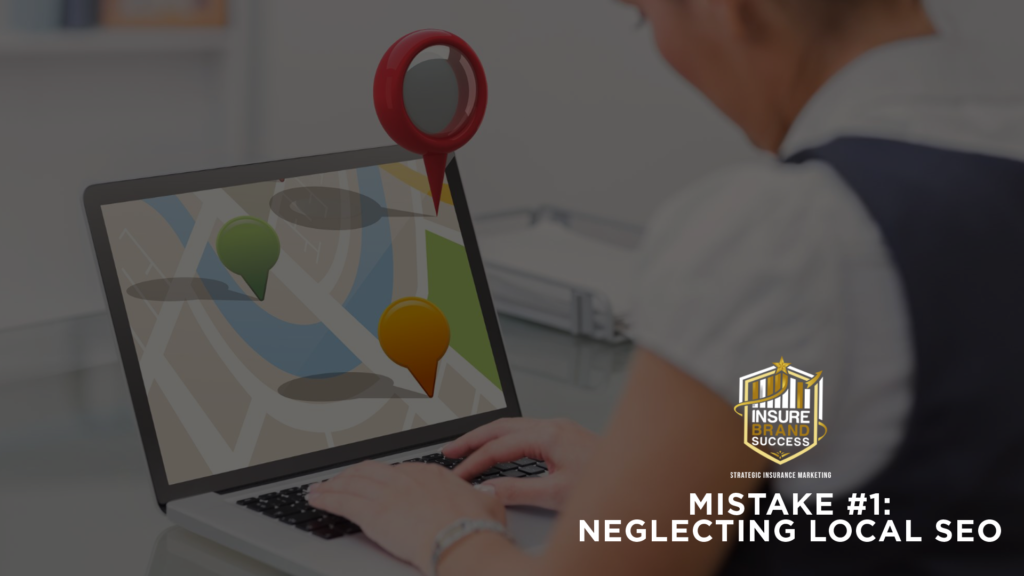
Imagine this: a young couple has just moved into your city and is searching for home insurance. They type “best home insurance agency near me” into Google. Your competitors pop up immediately, complete with glowing reviews and directions to their office. But where’s your agency? Nowhere to be found. Without Local SEO, you’re invisible to your community and losing out on countless leads.
For insurance agencies, local SEO is not just a marketing strategy; it’s a survival tool. Unlike online-only businesses, your clients are local, and they’re looking for a provider they can trust in their area. If your agency isn’t optimized for local searches, your competitors are taking the clients who should be yours.
Let’s break down why Local SEO is critical for insurance agencies and, more importantly, how you can fix this mistake.
Why Local SEO Matters for Insurance Agencies
Most insurance clients want an agency that understands their specific needs, whether it’s auto insurance for the icy roads in your region or commercial policies tailored to local industries. When people search online for insurance, 93% of them choose a business that appears on the first page of results. If your agency doesn’t rank locally, you’re practically invisible to potential clients who are ready to buy.
Here’s what local SEO does for you:
- Puts Your Agency on the Map (literally): When someone searches for “insurance near me,” local SEO helps your agency appear in the Google Maps pack, increasing visibility.
- Builds Trust Through Reviews: Positive Google reviews build credibility, showing prospects that your agency is a trusted name in the community.
- Drives High-Intent Leads: Local searchers aren’t casually browsing—they’re actively looking for solutions, making them more likely to convert.
How to Fix It: Local SEO Action Plan
1. Optimize Your Google My Business (GMB) Profile
Your Google My Business (GMB) profile is one of the most powerful tools for local SEO. It’s free, effective, and essential for ensuring your agency ranks in local searches.
Steps to Optimize GMB:
- Claim Your Listing: If you haven’t already, claim your GMB profile. Ensure the agency’s name, address, phone number (NAP), and website are correct.
- Complete Every Field: Fill out every section, including business hours, services, and attributes like “wheelchair accessible.”
- Add High-Quality Photos: Include images of your office, team, and even community events. Clients want to know they’re dealing with a real, local business.
- Encourage Reviews: Ask happy clients to leave reviews and respond to every review (positive or negative) to show you value feedback.
Pro Tip: Google rewards active profiles. Regularly update your GMB page with posts about new services, special promotions, or community involvement.
📖 Learn More: For a deeper dive into local SEO strategies, check out this guide from HubSpot.
2. Use Local Keywords Strategically
Keywords are the foundation of SEO, but for local SEO, they need to be location-specific. Think like your clients—what would they type into Google to find you?
Examples of Local Keywords:
- “Affordable auto insurance in [city]”
- “Business insurance for restaurants in [neighborhood]”
- “Best home insurance agencies in [state]”
Where to Include Keywords:
- Page titles and meta descriptions
- Service pages (e.g., “Auto Insurance in [City]”)
- Blog posts (e.g., “5 Reasons [City] Residents Need Flood Insurance”)
- Image alt text and captions
When you create localized content, Google associates your site with those specific areas, making you more likely to rank for searches in your community.
📖 Learn More: Explore our Insurance SEO Services to see how SEO can boost your local presence.
3. Build Local Citations and Backlinks
Google values consistency. Make sure your NAP information is identical across all directories and platforms, from Yelp to Facebook to insurance-specific directories.
How to Build Citations:
- List your agency on platforms like Yellow Pages, Yelp, and Angie’s List.
- Submit to local directories or industry-specific ones, such as TrustedChoice.com for insurance agents.
How to Earn Backlinks:
- Partner with local businesses or sponsor community events—they’ll often link back to your site.
- Write guest blogs for local publications or collaborate with local influencers.
These strategies not only boost your SEO but also strengthen your credibility in the local market.
📖 Learn More: Our Web Design for Insurance Agencies service can help you build a website optimized for local SEO.
4. Create Hyper-Local Content
Google loves fresh, relevant content—and so do your clients. By creating content tailored to your area, you show that your agency understands the unique needs of your community.
Examples of Hyper-Local Content:
- Blog posts: “Why [City] Drivers Need Comprehensive Auto Insurance During Winter”
- Guides: “The Ultimate Home Insurance Checklist for [Neighborhood] Residents”
- Seasonal Tips: “How to Protect Your Business from Hurricanes in [State]”
Not only does this type of content help you rank higher locally, but it also positions your agency as a trusted authority in the area.
5. Monitor and Improve Your Efforts
Local SEO isn’t a “set it and forget it” strategy—it requires ongoing attention. Use tools like Google Analytics and Google Search Console to track how your website performs for local searches. Regularly revisit your keywords, reviews, and content to ensure you’re staying ahead of the competition.
The Payoff: Dominating Your Local Market
Neglecting local SEO is like putting up a billboard on a deserted road. But when you focus on optimizing for local search, you make it easy for potential clients to find you, trust you, and choose you. It’s about building relationships with your community and ensuring your agency is the first name that comes to mind when they need insurance.
If you’re ready to boost your local SEO efforts, explore our Insurance SEO Services or schedule a consultation to create a tailored strategy for your agency.
Your clients are searching—make sure they find you.
Mistake #2: Using Generic Social Media Content

Imagine scrolling through your social media feed. Post after post looks the same—generic captions, stock photos, and content that feels like it was written by a robot. Would you stop to engage with any of it? Probably not. Now, think about your agency’s social media presence. Is it standing out and sparking conversations, or is it blending into the noise?
For insurance agencies, social media isn’t just about being present—it’s about being purposeful. Generic, cookie-cutter posts may fill up your feed, but they won’t build trust, generate leads, or position your agency as the go-to expert in your community. If your content doesn’t resonate with your audience, you’re missing the mark and wasting valuable time.
Why Cookie-Cutter Posts Don’t Engage Audiences
Social media is a crowded space. Your clients and prospects are bombarded with endless content daily, from friends, influencers, and competitors. Posting overly broad, bland, or recycled content does nothing to grab their attention. Here’s why generic content doesn’t work:
- It Lacks Personality: People want to connect with brands that feel human. Overused templates and generic captions don’t show who you are or why you’re different.
- It’s Forgettable: Your audience won’t remember another “Happy Friday!” post or a stock photo of a handshake. These posts don’t add value or leave an impression.
- It Doesn’t Speak to Their Needs: If your posts don’t address specific client concerns or answer their questions, they won’t see a reason to engage.
In short, social media is about connection, not perfection. If your content doesn’t reflect your agency’s unique personality or provide value, your audience will scroll right past it.
The “Aha Moment”: Social Media Can Be Your Secret Weapon
When used effectively, social media isn’t just a marketing tool—it’s a platform to tell your agency’s story, build trust, and start meaningful conversations. Instead of thinking of it as a chore, think of it as an opportunity to showcase what makes your agency special, educate your audience, and connect with potential clients on a personal level. The secret is creating content that feels authentic, relevant, and valuable.
How to Fix It: Tailored Social Media Strategies
1. Create Client-Focused Content
Your social media isn’t about you—it’s about your audience. What are their concerns, questions, and needs? Tailor your posts to address these.
Examples of Client-Focused Content:
- Educational Posts: Teach your audience something they need to know. For example:
- “5 Common Home Insurance Mistakes and How to Avoid Them”
- “Do You Need Comprehensive Car Insurance? Here’s How to Decide”
- FAQs Turned into Posts: Turn common client questions into engaging posts or short videos. For instance:
- Question: “What’s the difference between term and whole life insurance?”
- Post: A quick, visual explanation with a CTA to learn more.
By speaking directly to your clients’ needs, you’ll earn their trust and keep them engaged.
2. Share Client Stories and Testimonials
People connect with stories, not sales pitches. Show how your agency has made a difference in real clients’ lives by sharing testimonials or success stories.
How to Use Stories:
- Highlight a satisfied client’s journey, such as how your agency helped them navigate a tricky claim or find the right coverage.
- Use visuals like before-and-after scenarios, short interview-style videos, or even infographics.
- Tag clients (with permission) to build authenticity and encourage sharing.
Real-life examples humanize your agency and show potential clients the tangible benefits of working with you.
3. Promote Local and Community Engagement
As an insurance agency, you’re part of the local community. Let your audience see your involvement and commitment to their area.
Community-Focused Content Ideas:
- Share photos or videos from local events your agency sponsors.
- Celebrate milestones like your agency’s anniversary or team achievements.
- Highlight local partnerships or collaborations with small businesses.
- Create posts specific to local risks, such as “How [City] Homeowners Can Protect Against Flood Damage.”
By positioning yourself as a proud member of the community, you’ll build trust and familiarity with your audience.
4. Make Your Posts Visually Appealing
Social media is a visual-first platform. Posts that include eye-catching images, infographics, or videos perform significantly better than plain text.
Visual Tips for Social Media:
- Use tools like Canva or Adobe Express to create branded graphics.
- Post short, engaging videos that explain insurance concepts in a simple, relatable way. For example:
- A 30-second clip breaking down what renters’ insurance covers.
- Avoid overusing stock photos. Use real pictures of your team, office, or local landmarks instead.
📖 Learn More: Explore our Social Media for Insurance page for tips on creating engaging and authentic content.
5. Engage, Don’t Just Post
Posting content is only half the equation—engagement is where the magic happens. People want to know there’s a real person behind the posts, so make it a priority to interact with your audience.
How to Boost Engagement:
- Respond to Comments and Messages: If someone asks a question or leaves a comment, reply promptly. This shows you’re approachable and care about your clients.
- Ask Questions: Start conversations by asking your audience about their experiences or opinions. For example:
- “What’s the biggest question you have about car insurance?”
- “Have you ever filed a claim? What was the experience like?”
- Polls and Quizzes: Use interactive features like Instagram polls or LinkedIn quizzes to engage your followers and gather insights.
6. Use Paid Social Ads to Amplify Your Reach
While organic content builds relationships, paid social media ads help you expand your audience and target specific groups effectively.
Why Use Paid Ads:
- You can target audiences by demographics, location, interests, and behaviors.
- Retarget visitors who interacted with your website but didn’t convert.
- Promote lead magnets like a free quote or a downloadable guide.
📖 Learn More: Check out our AdWords for Insurance Agencies for additional ways to integrate paid advertising with your strategy.
The Payoff: Build Relationships, Not Just Posts
When you stop using generic, cookie-cutter content and start tailoring your social media to your audience’s needs, you’ll see a real difference in how people engage with your agency. Social media is your chance to show that you’re not just another insurance provider—you’re a trusted partner, a community member, and an expert who genuinely cares.
If you’re struggling to create effective social media content, explore our Social Media for Insurance service for guidance on building a strategy that drives real results.
The key takeaway? Stop blending in and start standing out. Your audience is online, waiting to connect—give them a reason to choose your agency.
Mistake #3: Ignoring Mobile Optimization
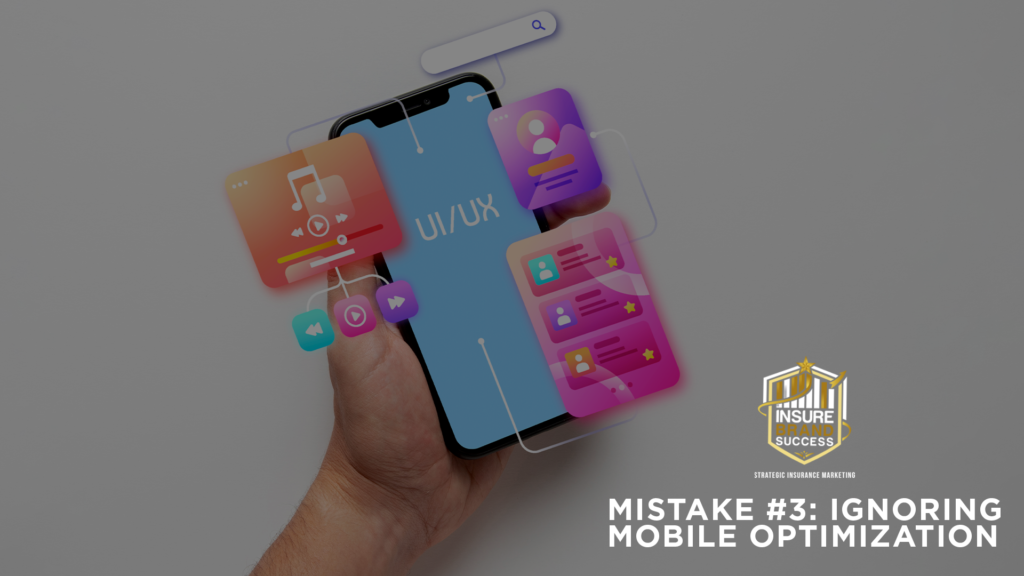
Imagine this scenario: A potential client hears about your agency and decides to check out your website while they’re on their lunch break or commuting home. They open your site on their phone, and what do they find? Tiny text, awkward navigation, pages that won’t load properly, or buttons that don’t work. Frustrated, they hit the back button and go straight to your competitor’s website—one that actually works on mobile.
In a world where over 60% of web traffic comes from mobile devices, ignoring mobile optimization isn’t just a mistake—it’s a deal-breaker. A website that isn’t mobile-friendly tells potential clients one thing: your agency isn’t keeping up with the times. And if they don’t trust your website, why would they trust you with their insurance needs?
Why Mobile Optimization is Critical for Insurance Agencies
Think about your audience. Many of your potential clients are busy individuals—parents juggling family life, small business owners managing hectic schedules, or young professionals constantly on the move. When they’re looking for insurance, they’re not sitting at a desktop—they’re searching from their phones or tablets.
Here’s why mobile optimization is non-negotiable:
- First Impressions Matter: Your website is often the first interaction a potential client has with your agency. A clunky, non-mobile-friendly site creates a poor first impression and immediately drives them away.
- Google Demands It: Google prioritizes mobile-friendly websites in its search rankings. If your site isn’t optimized for mobile, you’re less likely to appear in search results—period.
- It’s What Clients Expect: Clients today expect seamless, fast, and user-friendly experiences on all devices. If your site doesn’t meet these expectations, they’ll find one that does.
The “Aha Moment”: Your Website is Your Digital Office
Think of your website as your agency’s digital office. Would you invite clients into a messy, disorganized space with no clear direction? Of course not. A mobile-friendly website is your opportunity to create a welcoming, professional experience that makes clients feel confident in choosing you. When your website works seamlessly on mobile, it shows that your agency is modern, client-focused, and ready to meet their needs.
How to Fix It: Mobile Optimization Strategies
1. Adopt Responsive Design
The foundation of a mobile-friendly website is responsive design. This means your site automatically adjusts to fit any screen size, whether it’s a smartphone, tablet, or desktop.
Key Features of Responsive Design:
- Text and images resize automatically for readability.
- Navigation menus are easy to tap and don’t require zooming in or out.
- Forms and buttons are large enough to click without frustration.
A responsive design ensures that your website looks professional and functions perfectly, no matter what device your audience is using.
📖 Learn More: Explore our Web Design for Insurance Agencies service to see how responsive design can transform your site.
2. Speed Matters: Optimize for Fast Loading
A slow-loading website is a conversion killer. In fact, 53% of mobile users will abandon a site if it takes more than 3 seconds to load. Every second counts when it comes to capturing and retaining your audience’s attention.
How to Improve Loading Speeds:
- Compress Images: Large image files slow down your site. Use tools like TinyPNG to reduce file sizes without sacrificing quality.
- Enable Caching: This stores elements of your website on users’ devices, making it faster to load when they return.
- Minimize Code: Remove unnecessary code or plugins that can bloat your site and slow it down.
Fast-loading pages show clients that your agency respects their time—an important factor in building trust.
3. Simplify Quote Forms for Mobile
Insurance is all about convenience. If a potential client is ready to request a quote or consultation, they need to be able to do it quickly and easily on their phone.
Mobile-Friendly Quote Form Tips:
- Use large input fields that are easy to type into on a touchscreen.
- Minimize the number of required fields. Ask for only the essentials upfront, like name, contact info, and type of coverage.
- Add a progress bar for multi-step forms, so users know how much longer it will take.
- Include a click-to-call button for those who prefer to speak with someone directly.
By making it simple to get a quote or contact your agency, you’re removing barriers and making it easier for clients to take the next step.
4. Test, Test, Test
Even if your website claims to be mobile-friendly, it’s crucial to test it on different devices and browsers to ensure everything works as intended.
How to Test Your Site:
- Use Google’s Mobile-Friendly Test Tool to identify any issues.
- Test your site on real devices—iPhones, Android phones, tablets, etc.
- Check for usability issues like cut-off text, overlapping elements, or broken links.
Regular testing ensures that your site stays user-friendly as technology and client expectations evolve.
📖 Learn More: For more guidance on creating a seamless mobile experience, check out this resource from Google’s Mobile Optimization Guide.
5. Don’t Forget About Local SEO on Mobile
Most mobile searches for insurance agencies include phrases like “near me” or “[city] insurance agency.” By optimizing your website for local SEO, you increase the chances of appearing at the top of search results for mobile users.
Local SEO Tips for Mobile:
- Make sure your address, phone number, and hours of operation are easy to find on every page.
- Optimize your Google My Business profile for mobile users.
- Include clickable directions to your office, making it simple for clients to find you.
Mobile optimization and local SEO go hand-in-hand to ensure your agency is visible and accessible.
The Payoff: A Website That Converts on Any Device
A mobile-friendly website isn’t just a nice-to-have—it’s a must-have. It’s how you meet your clients where they are, make a great first impression, and ensure that your digital presence matches the professionalism of your agency. By adopting responsive design, simplifying quote forms, and optimizing for speed, you’re creating a seamless experience that converts visitors into loyal clients.
If you’re ready to bring your website into the modern age, explore our Web Design for Insurance Agencies page for tailored solutions that ensure your site works perfectly on any device.
Your clients are searching on their phones. Make sure your agency is ready to meet them there. Because if your site doesn’t work on mobile, your competitors’ will.
Mistake #4: Sending Generic Email Blasts
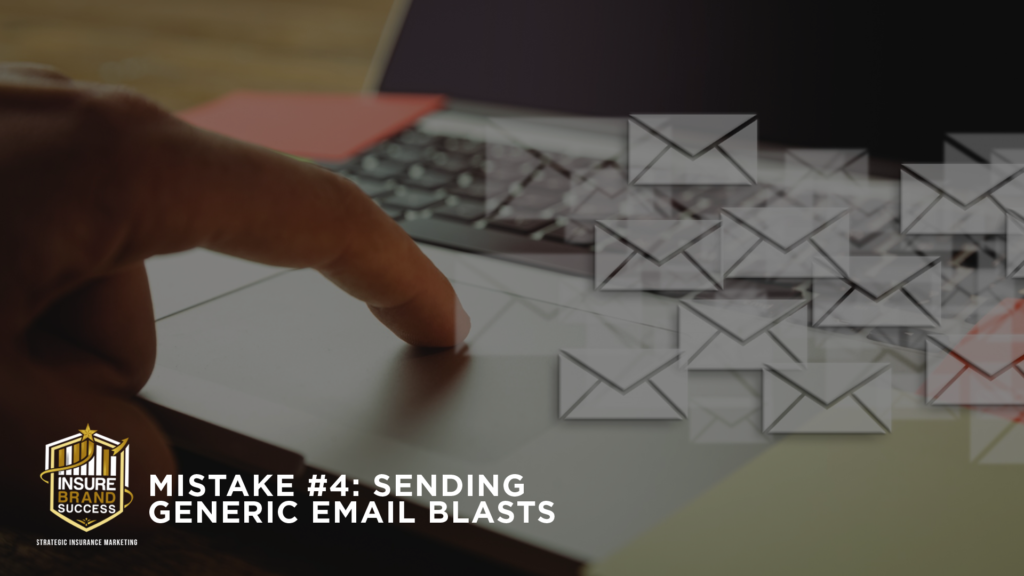
Let’s be honest—how do you feel when you open your inbox and see another impersonal, generic email that could’ve been sent to anyone? Chances are, you delete it without a second thought—or worse, mark it as spam. Now flip the perspective. If your insurance agency is sending out bland, one-size-fits-all emails, your audience is likely doing the same thing: hitting delete, ignoring your message, or unsubscribing altogether.
Email marketing remains one of the most powerful tools for reaching your audience, but only if you do it right. The days of sending generic email blasts are over. Modern clients expect communication that feels tailored, relevant, and human. If your emails aren’t speaking directly to their needs, you’re not just losing their interest—you’re potentially damaging your agency’s credibility.
Why Generic Emails Don’t Work
A generic email is like a cold handshake—it lacks warmth, connection, and intention. Here’s why they fail:
- They Feel Impersonal: Starting an email with “Dear Valued Customer” or sending the same message to everyone screams “I don’t know who you are.”
- They Aren’t Relevant: If someone inquiring about auto insurance gets an email about home insurance, they’ll feel disconnected from your agency.
- They Don’t Build Trust: Your clients want to know you understand their specific needs. Sending generic content gives the opposite impression.
Think of it this way: Would you respond better to an email that says, “Hi [First Name], here’s how we can help protect your family with affordable life insurance” or one that says, “Check out our insurance plans”? Personalization makes all the difference.
The “Aha Moment”: Email as a Personal Connection
Email marketing isn’t just a numbers game—it’s about building relationships. Every email you send is an opportunity to connect with your audience on a deeper level. When you personalize your emails and show your audience you truly understand their needs, they’re far more likely to engage with your agency, trust your expertise, and ultimately, choose you over the competition.
How to Fix It: Segmentation and Personalization Strategies
1. Segment Your Email List
Segmentation is the foundation of impactful email marketing. It means dividing your audience into smaller groups based on shared characteristics, such as their insurance needs, location, or stage in the customer journey.
Ways to Segment Your Email List:
- By Policy Interest: Group clients based on whether they’re interested in auto, home, life, or business insurance.
- By Client Status:
- New leads: People who’ve recently requested a quote or filled out a contact form.
- Current clients: Policyholders who might be interested in renewals or cross-selling opportunities.
- Inactive clients: Past customers who haven’t engaged recently.
- By Demographics: Tailor content for families, small business owners, or retirees, depending on who your audience is.
By sending emails to specific segments, you can deliver messages that feel targeted and relevant, increasing your open rates and engagement.
📖 Learn More: Explore how segmentation can supercharge your campaigns with our Insurance Email Marketing solutions.
2. Personalize Every Email
Personalization goes beyond just adding someone’s first name to the subject line. It’s about creating content that feels like it was written specifically for the recipient.
How to Personalize Emails:
- Use the recipient’s name in the subject line or greeting (e.g., “Hi Sarah, here’s how we can protect your home this winter”).
- Reference past interactions, such as a quote request: “Thanks for reaching out about auto insurance. Here’s what you need to know.”
- Offer tailored solutions: If someone has expressed interest in life insurance, send them emails about policy options, not general content about your agency.
Pro Tip: Use tools like Mailchimp or Brevo to automate personalization at scale, ensuring every email feels unique without added manual effort.
3. Create Value-Driven Content
Your emails shouldn’t just sell—they should inform, educate, and add value. Clients are more likely to engage with your agency if they feel they’re gaining something useful from your emails.
Examples of Value-Driven Email Content:
- Tips and Guides: “5 Ways to Lower Your Home Insurance Premiums” or “What You Need to Know About Flood Insurance in [City].”
- Seasonal Content: “Winter Driving Tips: Stay Safe and Save on Auto Insurance.”
- Policy Updates: “What Changes to [State] Insurance Laws Mean for You.”
- Client Stories: Share real-life examples of how your policies helped someone in need.
Educational content not only establishes your agency as a trusted expert but also keeps your audience looking forward to your emails.
4. Automate Follow-Ups
Automation ensures you never miss an opportunity to engage with your leads or clients. It allows you to send timely, relevant messages based on specific triggers, such as signing up for a newsletter or requesting a quote.
Examples of Automated Email Sequences:
- Welcome Series: Send a series of emails introducing new leads to your agency, highlighting your services and expertise.
- Email 1: Welcome and overview of your agency.
- Email 2: Tips for choosing the right insurance policy.
- Email 3: Call-to-action for scheduling a consultation or requesting a quote.
- Renewal Reminders: Automatically remind clients when their policies are due for renewal.
- Lead Nurturing: Follow up with leads who requested a quote but didn’t convert.
Automation ensures consistent communication without overwhelming your team.
📖 Learn More: Check out Insurance Email Marketing to discover tools and strategies for automated email campaigns.
5. Test and Analyze Your Campaigns
The best email marketing strategies are built on data. Regularly track your email performance to see what’s working and where you can improve.
Key Metrics to Monitor:
- Open Rate: Indicates how compelling your subject lines are.
- Click-Through Rate (CTR): Measures how many recipients clicked on links in your email.
- Conversion Rate: Tracks how many recipients took a specific action, such as requesting a quote or scheduling a consultation.
- Unsubscribe Rate: High unsubscribe rates could signal that your content isn’t resonating with your audience.
Use A/B testing to experiment with different subject lines, content formats, and CTAs to see what drives the best results.
The Payoff: Turning Emails into Conversations
When you stop treating email marketing as a one-size-fits-all approach and start focusing on segmentation, personalization, and value, you transform your emails from ignored blasts into meaningful conversations. This builds trust, strengthens relationships, and keeps your agency top-of-mind for clients—whether they’re ready to buy now or later.
If you’re ready to take your email campaigns to the next level, explore our Insurance Email Marketing service for expert guidance on creating impactful, client-focused campaigns.
Remember: It’s not about sending more emails—it’s about sending the right emails to the right people at the right time. When done right, email marketing becomes one of the most powerful tools in your digital strategy.
- Conclusion: Reiterate the importance of addressing these mistakes and invite readers to a free strategy session.
Newsletter Lead-In:
Subject Line: “Are These Digital Marketing Mistakes Costing Your Insurance Agency Leads?”
Preview Text: “From local SEO to social media, discover the 5 biggest mistakes insurance agencies make—and how to fix them fast.”
Body: Briefly introduce the blog, highlight one or two mistakes, and include a CTA:
“Click here to read the full post and discover how to take your digital marketing to the next level!”
This blog + newsletter combo not only provides value but also drives engagement and leads to your services. Want me to draft the blog in full? Let me know!

